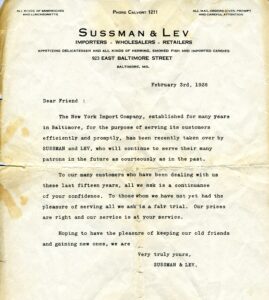Bedlam with Corned Beef on the Side Part VI
Written by Barry Kessler. Originally published in Generations 1993, reprinted in Generations 2011 – 2012: Jewish Foodways.
Part VI: The Full-Scale Delicatessen Restaurant

Sussman and Lev delicatessen, c.1930. Gift of Martin Lev, JMM 1991.140.002
From the 1920s onward, deli restaurants thrived in Jewish neighborhoods in East Baltimore, around North Avenue, and outward to the northwestern suburbs, Several delis appeared in commercial districts, notably the Globus near the west-side garment district, Mandell’s on Baltimore Street downtown, and Awrach and Perl near the big Howard Street department stores. By general agreement, Sussman and Lev, Awrach and Pearl, Ballow’s, Nates and Leon’s, and Attman’s are considered the outstanding names in a throng of memorable institutions, each of which rang a slightly different variation on the theme of sliced meats, smoked fish, hot dogs, sandwiches, and pickles.
The delicatessen restaurant got a strong boost with the arrival of supermarkets. These clean, spacious stores with wide selections and low prices forced small groceries of all kinds to adapt or go out of business. For many of those specializing in delicatessen, the best alternative was to expand upon their incipient function as a restaurant, or convert fully to restaurant service, while maintaining the old atmosphere. Other social trends were pushing them in the same direction: Jewish families were prospering and could better afford to eat out; they were spreading out around the city; and, as younger Jews had less direct knowledge of European tradition, they were less likely to prepare Jewish specialties at home, but still wanted to participate in these traditions, at least on special occasions.[1]

Interior of Sussman and Lev, c.1930. Gift of Martin Lev, JMM 1991.140.003
Sussman and Lev’s was probably the first full-scale delicatessen restaurant in Baltimore, and one of the longest-lived and best-known. In 1915, Jacob Hyman Sussman became the proprietor of the New York Import Company, which specialized in smoked fish. He lived above his store at 905 East Baltimore Street. Sussman was 23 years old, unmarried and just naturalized, an immigrant tailor from Svisloch, a village in the Russian province of Minsk.[2] New York Import had first appeared in the City Directory two years earlier, under the ownership of Abraham Gelfand, who resurfaced briefly in 1918 as a partner in the company with Jacob Sussman.[3]
Sussman’s company thrived. In 1922 it was offering “imported and domestic herring, smoked fish, canned goods and delicatessen” at 917 East Fayette Street; Jacob H. and Isador Sussman and Nathan Leo were the proprietors. Both Sussman families lived uptown at 2217 Bryant Avenue.[4] In 1926 Jacob Sussman was secretary-treasurer for Nathan Davis and Company, a competing fish seller; Morris Scherlis was its vice-president. In the same year, however, Sussman went into partnership with Carl Lev, an immigrant from Poland or Russia – via Chile – who had had a delicatessen in New York.[5] They were importers, wholesalers, and retailers of “appetizing delicatessen and all kinds of herring, smoked fish, and imported candies” at 923 East Baltimore Street. The “New York Import Company…has been recently taken over by SUSSMAN and LEV,” read the letter they sent “to our many customers who have been dealing with these last fifteen years.”[6]

Letter indicating that Sussman & Lev are taking over the New York Import Company, February 3, 1926. JMM 1991.140.001
Photographs of 923 East Baltimore Street around this time reveal the operation of the business. One shows the interior, with two parallel counters, each with scales and slicers, piled high with meats and breads. The walls are lined with canned goods in neat rows; two dozen salamis hang from a shelf. Cans of Lord Calvert and Hotel Belvedere coffee compete with boxes of crackers and barrels of pickles for floor space, and a marble-topped table and four bentwood side chairs squeeze into the back. The menu is a framed sign offering appetizing salads, sandwiches, pickles, fish, delicatessen, and soft drinks.
In another photograph the countermen stand at the end of the central aisle, while customers are seated at the table, one in a derby hat. Wrapped candies and dried fruit, a slab of halvah, and pieces of whitefish and salmon lie on the counters in the foreground. Photographs at the Maryland Historical Society of exterior views show a huge vertical lighted sign reading DELICATESSEN and windows full of nuts, packaged products, and smoked fish. Signs in English, Yiddish, and Russian announce “all kinds of sandwiches/luncheonette, wholesale and retail appetizing/delicatessen.”[7]
In 1935 the restaurant expanded, adding an art-deco style bar, a ceramic tile floor, and a section of tables in booths.[8] A Viennese baker from New York was brought in to prepare “delicious rolls, pie, cakes and pastries.”[9] 1939 brought air-conditioning and a catering hall upstairs, which could be rented for bar mitzvah luncheons and other small receptions. A menu from this era shows that the restaurant served an enormous variety of dishes. Sandwiches ranged from lox and cream cheese on a bagel to a “Broadway Special” combination of tongue, spiced beef, corned beef, salami, sweet gherkin and lettuce. One could dine on “cold schov with hard egg,” broiled veal steak with fresh mushrooms, and pie, washed down with beer, almond smash soda, or buttermilk. Sussman and Lev’s remained a favorite of Jews who worked in East Baltimore long after the neighborhood’s ethnic makeup had changed. It went out of business around 1951.
Continue to Part VII: Sandwich Innovation
Notes:
[1] See Jack Kugelmass, “Green Bagels: An Essay on Food, Nostalgia, and the Carnivalesque,” YIVO Annual, 1990, for a fascinating exploration of delicatessen traditions carried to their extremes by younger generations.
[2] Interview with Harold Sussman (July 1991).
[3] Baltimore City Directories. In 1930 Abraham Gelfand was treasurer of the Pickle Products Company.
[4] Baltimore City Directories, 1913, 1922.
[5] Interview with Martin Lev (July 1991).
[6] Gift of Martin Lev, 1991.140.1
[7] Photos by Hughs Company, Baltimore City Life Museums Collection.
[8] Interview with Harold Sussman (July 1991).
[9] Baltimore Jewish Times, January 2, 1940.
